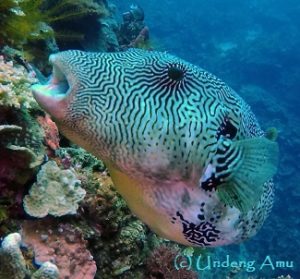Loading content - please wait...
Mappa Puffer Video
Mappa puffer are usually solitary and wary of divers. One day, however, guests of Miguel’s Diving found one that was too busy eating to care that divers approached for a rare
, up-close encounter.
One Pufferfish, Many Names

Miguel’s Diving staff call this fish Mappa puffer because its scientific name is Arothron mappa. Other English names include Map puffer, Arothron puffer, Scribbled Arothron puffer and Scribbled puffer. Additionally, this fish can be called pufferfish or simply puffer. Sometimes, pufferfish are called toadfish. As a result, this introduces additional name variations.
Mappa puffer live in tropical and subtropical oceans. Their distribution ranges from the Indian to western Pacific oceans. The key to distinguishing this species from other pufferfishes are the lines that radiate from its eyes. It can grow up to 65 cm in length. Also
, pufferfishes like this species lack scales. Divers will see them during the day.
Mappa Puffer Video
This type of pufferfish eats about anything that does not move. It cannot swim fast because of its small fins. Hence, its diet mainly consists of sponges, algae, clams and even coral. However, the Mappa puffer recently encountered in Gorontalo repeated selected something surprising to crunch. Watch the video to see!
This feeding behavior raises questions. Why is it eating dead coral? How can such a soft fish crunch hard coral to bits? The answer perhaps lies inside the mouth of Mappa puffer. It has four strong teeth that keep growing. As a result, this type of pufferfish must crunch on hard things to wear down its teeth.
Eaten at Your Own Risk
As with other pufferfishes, the Mappa puffer can ingest large amounts of water when threatened. In this way, it can swell to twice its usual size. This is how it avoids being eaten. However, pufferfishes like this species are poisonous. Their livers, ovaries and skin contain tetrodotoxin. That poison is an extremely toxic sodium channel blocker. That blocker affects both the central and peripheral nervous systems. Most importantly, it causes paralysis.
The Japanese consider pufferfish meat a delicacy. They call it fugu. Only specially licensed chiefs have permission to prepare the meat. The chief must carefully remove Internal organs and skin prior to consumption. A low dose of tetrodotoxin causes tingling and numbness in the mouth, fingers and toes. Symptoms of a higher dose include nausea, vomiting, difficulty in walking, and paralysis. Most importantly, that paralysis can negatively affect the lungs, leading to respiratory failure. Only one to four milligrams is needed to kill an adult!
Tetrodotoxin has no antidote. The treatment required for recovery is artificial breathing. Mild poisoning can resolve itself within a few hours. More severe cases can require several days. This treatment is considered successful since many people make a full recovery. Heart failure is rare. Most importantly, treatment must begin before paralysis reaches the lungs.
Like many poisons, this one has medical benefits in controlled doses. New studies indicate that it can relieve pain in cancer patients. As such, it could become an alternative for opiates.
Actually, pufferfishes like Arothron mappa are not poisonous themselves. Symbiotic bacteria living inside their tissues produce the poison.
To see but not eat a Mappa puffer in Gorontalo, please book your dive trip with us.





